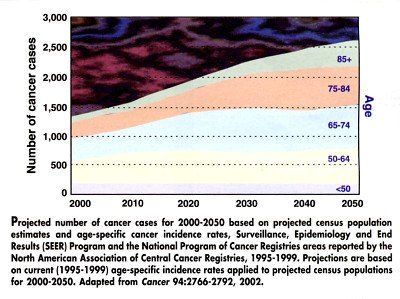Cancer Incidence to Double by 2050 Due to Population Growth, Aging
BETHESDA, Maryland-Total annual cancer cases will likely double in the United States during the first half of the 21st century, with 2.6 million people diagnosed with the disease in the year 2050, according to a new federal report (see Figure). The major driving force for this projected increase is the growth and aging of the American population, which will sharply increase the number of cases even if the cancer rate remains constant.
BETHESDA, MarylandTotal annual cancer cases will likely double in the United States during the first half of the 21st century, with 2.6 million people diagnosed with the disease in the year 2050, according to a new federal report (see Figure). The major driving force for this projected increase is the growth and aging of the American population, which will sharply increase the number of cases even if the cancer rate remains constant.

Physicians diagnosed 1.3 million cancers in 2000. The projected cancer burden a half-century from now assumes that cancer rates will follow current patterns and that the number of Americans age 85 and older will quadruple during the same period.
"The data presented in the report underscores the critical need for expanded and coordinated cancer control efforts to serve an aging population and reduce the burden of cancer in the elderly," said Richard J. Hodes, MD, director of the National Institute on Aging.
New Standard Population
For the first time, the NCI has changed its calculation of its age-adjusted cancer rates. During the past 3 decades, age adjustment has been made based on a 1970 standard population. Now the Institute has moved to a year 2000 standard population, a change adopted by all federal health agencies because of the soaring number of elderly Americans.
As a result, NCI said, "cancer rates adjusted to the year 2000 standard will be higher because more emphasis is given to the patterns for older persons, who have higher rates of cancer." In fact, almost all statistics for health conditions and deaths that affect older persons will appear higher when adjusted to the 2000 standard.
"Thus," NCI said, "comparisons of rates adjusted to the 2000 standard are possible, while comparisons between rates adjusted to different standards, such as 1970 and 2000, are not valid."
The new report concludes that cancer death rates declined for all age groups during the 1990s. Overall, the death rate decreased just over 1% a year from 1993 to 1999 and a total of 6% between 1990 and 1999. However, people less than age 65 had a greater decrease than those 65 and older, and because of the aging US population, the total number of cancer deaths for all ages rose about 9% during the 1990s.
The cancer incidence stabilized overall from 1995 to 1999, although the rate for women rose between 1987 and 1999, largely because of increased rates among women age 50 and older. Rates for new cancers declined for black men from 1992 to 1999 and stabilized for white men.
Four Most Common Cancers
Prostate, breast, lung, and colorectal cancers were the four most commonly occurring malignancies, and the new statistics show some encouraging changes during the 1990s in incidence and death rates:
- The incidence rates for prostate cancer increased for men in all age groups less than 65, but the death rates continued to decline.
- Breast cancer incidence rates increased for women age 50 to 64 in the 1987 to 1999 period, but death rates declined.
- Incidence rates for lung cancer decreased for men less than age 50 and in most age groups 50 and older. The disease decreased among women in most age groups but continued to increase in older women. Lung cancer death rates decreased in men of all ages during the 1990s and among women less than age 65, but continued to rise in women in the 65 to 74 age group.
- Colorectal cancer incidence decreased in men less than age 50 and in most age groups older than 50. In women, the disease rate increased among those under age 50 and age 65 to 74, and decreased in other age groups.
The report was published in the May 15 issue of Cancer (94:2766-2792, 2002). For more information, go to SEER’s website at http://www.seer.cancer.gov.